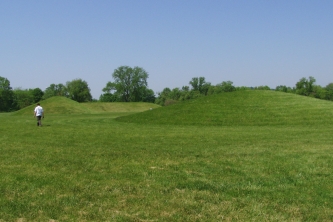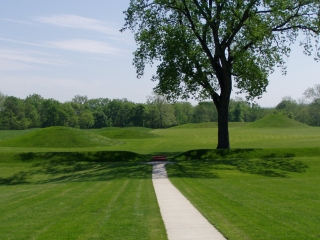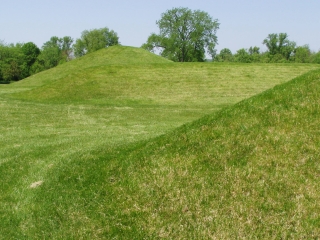Local Website
 WHAT IS IT?
WHAT IS IT?A 13-acre rectangular enclosure called Mound City that contains over 20 burial mounds and earthworks believed to have been created by the Eastern Woodlands Hopewell Native American culture about 2,000 years ago.
BEAUTY (4/10)
The many domed-shaped burial mounds enjoy a gentle grace and mysterious profundity. Movement around the rectangular enclosure significantly alters the way the mounds interact. It can be very beautiful. When built, Mound City was a part of a great chain of burial mounds, of which few remain. Farmers destroyed most to flatten the land for farming. So, at Hopewell, instead of broad vistas, you get the relatively small Mound City group surrounded on all edges by forest. A few hundred yards over the forest on the east and south sides of the Park are two massive Ohio State Prisons. Maybe the trees are not such a bad idea.
HISTORICAL INTEREST (5/10)
No one knows. We found it amusing that numerous qualifiers prefaced every explanation of the mounds’ historical role offered at Hopewell Culture NHP. The mounds’ significance could range from an elaborate and accurate map of the stars or it could be just a way to honor their dead. Your guess is as good as anyone else’s.
While the video and the museum make cursory attempts to explain the Hopewell Native Americans, the Site focuses on the mounds. The National Parks System all but ignores Native American life east of the Mississippi. When mentioned, they are either our enemies in battle and savages whose eradication paved the way for are lives today or given only the first minute in historical explanations of natural sites. We're paraphrasing: ‘Yes they inhabited this land for thousands of years but what happened in the last two hundred years or so is far more important.’ A National Parks Site somewhere in the northeast dedicated to the lives of Native Americans would be nice. They lived here too.
 CROWDS (5/10)
CROWDS (5/10)We went on a beautiful Saturday afternoon and ran into few people at the Site. At the same time, only one or two people wandering near the mounds can ruin any picture opportunity. The Site is small. The Site’s museum is even smaller. More than 10 people inside the narrow corridor would make enjoyment and learning difficult.
EASE OF USE/ACCESS (2/5)
Chillicothe, Ohio is located within an hour and a half’s drive on two lane roads of Dayton, Columbus and Cincinnati Ohio. It is not as out of the way as it seems.
Wheelchair access may be difficult as the Mound Complex is, of course, on grass.
CONCESSIONS/BOOKSTORE (4/5)
There is a good selection of Eastern Woodland Native American books. The Site does not limit itself to books related only to burial mounds. We answered some questions raised by the video by paging through the store’s books.
COSTS (3/5)
Entrance fee is $4 per vehicle or $2 per person if you come alone. The Site is free with the National Parks Pass.
RANGER/GUIDE TO TOURIST RATIO (1/5)
We saw no Rangers. There is a confusing interactive computer program in the Site’s small museum that raises more questions than it provides answers. We left Hopewell Culture NHP understanding less than we did when we got there. A Ranger would have helped.
TOURS/CLASSES (5/10)
The video is vague and abstruse to the point of hilarity. It may be interesting but it explains nothing. Why, where, how, and when are all answered with we don’t know but it could be this, this or even this all while mysterious music plays in the background.
The Site’s museum, while painfully small, has many interesting artifacts on display that have been unearthed from the burial mounds. We thought they were amazing as does the venerable British Museum which displays artifacts found beneath the Mound City earthworks.
The interpretive walk around the Mounds looks promising on the brochure but in reality it is just a walk in the woods. You are very close to Mound City but trees obscure all views. The walk is useless.
 FUN (4/10)
FUN (4/10)The Mounds are fascinating and elicit a lot of thought and conjecture. What if farmers had not plowed most of them? What would they look like from above? Why did they have to build two large prisons just yards from the National Park Site?
WOULD WE RECOMMEND? (2/10)
Many things at Hopewell Culture NHP disappointed us: the penal surroundings, the Park Ranger void, the smallness of the museum and the mounds themselves. There were not nearly as many as we had imagined and they did not have a unique shape. Not all is lost, as we will visit two more burial mound sites, one in Iowa and one in Georgia. Maybe then our many questions will be addressed.
TOTAL 35/80
www.usa-c2c.com
© 2004-06